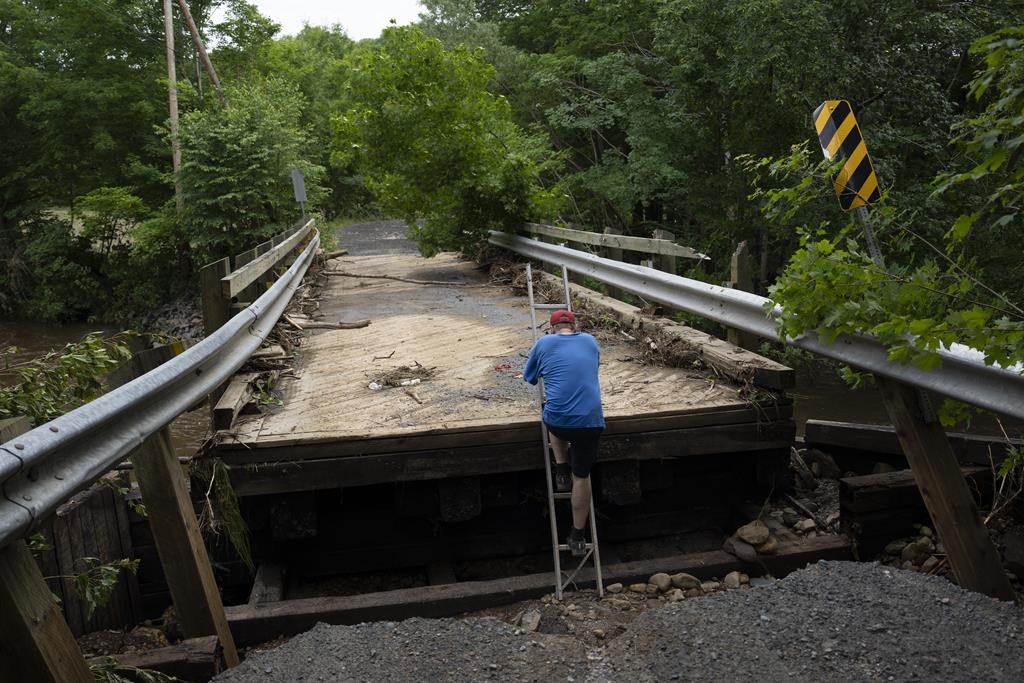An emergency alert warning people to stay home during recent flooding in Nova Scotia took close to two hours to send, say firefighters who responded to the disaster as bridges fell and roads crumbled.

Deputy chief Brett Tetanish of the volunteer fire department in Brooklyn, N.S., said in a recent interview that he asked the emergency dispatcher at 1:12 a.m. on July 22 to request an Alert Ready notice calling for residents to “shelter in place” and call 911 if they needed rescue or had a medical emergency.
At the time, he was in his fire truck and witnessing widespread washouts of roads and damage to bridges. However, the first alert prepared by the local Emergency Management Office of the Municipality of West Hants was not issued until 3:06 a.m., as about 250 millimetres of rain descended on the area.
Joanna Eyquem, managing director of climate-resilient infrastructure at University of Waterloo’s Intact Centre, who specializes in climate adaptation, said a two-hour timeframe appears to be too long during a major flooding emergency.
“I think the sooner you can get the message out the better. And two hours does seem quite a long time that people could be putting themselves in danger,” she said in an interview Friday.
RCMP have said that two cars were swept off a road into a hayfield July 22 near Brooklyn, located northwest of Halifax, between 3 a.m. and 3:30 a.m., resulting in the deaths of two six-year-old children — Colton Sisco and Natalie Harnish — who were both in one car, and 52-year-old Nicholas Holland and 14-year-old Terri-Lynn Keddy, who were passengers in another vehicle.
- As Canada’s tax deadline nears, what happens if you don’t file your return?
- Posters promoting ‘Steal From Loblaws Day’ are circulating. How did we get here?
- Video shows Ontario police sharing Trudeau’s location with protester, investigation launched
- Is $10/day child-care at risk of ‘derailment’? Report spurs questions
Jason Cochrane, chief of the Brooklyn fire department, said he had not had experience with the Ready Alert system until that night, adding that the region’s Emergency Management Office and his department need more training on flooding scenarios.
“We need to practise that process … the sooner you activate it (Alert Ready), the better it is for the citizens affected,” Cochrane said.
Cochrane said that the morning of the flooding he told the director of the local Emergency Management Office that the alert Tetanish had requested should emphasize that residents stay put. “Our victims were people trying to leave in cars and step out of their homes,” he said.
Mark Phillips, the municipality’s chief administrative officer, said in an email regarding the two-hour delay in sending the alert, “We are now preparing the event notes and reports for all parties. Once all the information is collected and recorded details will be available.”
In an interview with CTV earlier this week, Municipality of West Hants Mayor Abraham Zebian told the news network that there was poor cellular service in the area and difficulties in communications between the EMO manager and the firefighters.
Tetanish’s request for an emergency alert went to the RCMP, but a spokesman for the Mounties said Friday the RCMP is not mandated to send Ready Alerts for natural disasters. Cpl. Christ Marshall said the dispatcher was advised to contact EMO at 1:14 a.m., just two minutes after Tetanish called in.
In addition, Marshall said that at 1:22 a.m., the supervisor at the RCMP’s central communications centre called the EMO’s co-ordination centre to request an emergency alert be issued with regard to the flooding, as requested by the Brooklyn fire department. Marshall said the RCMP followed up at 2:11 a.m., asking for the status of the alert and were informed “that the alert was being worked on.”
And while residents received the alert at 3:06 a.m., they got another one 35 minutes later with a contradictory message. Instead of sheltering in place, residents were told to evacuate, based on the possibility of a dam breaching on the St. Croix River.
The Ready Alert told them to go to a civic centre in a low-lying area, which Tetanish said many residents wouldn’t have been able to safely reach. “The people from that area that were in danger … wouldn’t have been able to get there, but the people who put that alert out were probably not aware of that at the time,” Tetanish said.
The alert for the potential dam breach was later rescinded, after municipal officials determined the dam was unlikely to break.
Heather Fairbairn, a spokeswoman for the provincial Emergency Management Office, said when it receives a request to send out an alert it “responds quickly to get the information out,” adding “the content and timing of those alerts would be determined by the municipality.”
She said the department offers training and support to municipal emergency managers, “including opportunities to participate in exercises designed to help practice emergency management measures before an incident occurs.”
“When major incidents happen, a debrief will be done with our partners to understand the impacts and make improvements for future events. The use of the Alert Ready system will certainly form part of those discussions,” Fairbairn said in an email.
However, Eyquem said that Canadian jurisdictions need to take a wider approach to improving readiness for flooding and using Ready Alert. She said Canada needs to move toward a United Kingdom model, where watershed management agencies estimate where waters will flow based on flood forecasting software, and are capable of issuing detailed warnings to homes based on their location.
“I think you need to have predetermined levels of risk that are being agreed in advance, according to modelling … it shouldn’t be a judgment call on the fly,” Eyquem said.
This report by The Canadian Press was first published Aug. 4, 2023.




Comments